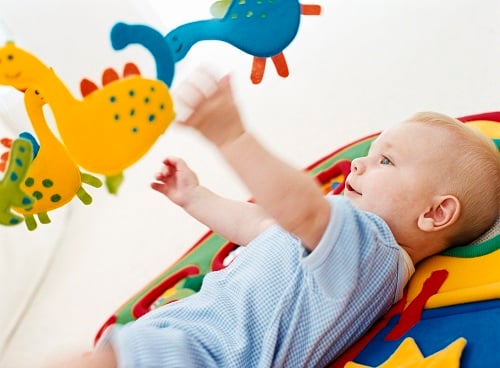Baby Acne
It’s very common for a baby’s beautiful, smooth skin to develop bumps and pimples. These little blemishes can pop up at any time from birth to a few weeks after they are born.
But, don’t worry! Baby acne is nothing to worry about. Let’s take a quick look at what causes it and the best ways to treat it.
What does baby acne look like?
It can appear as small bumps around your newborn’s forehead, cheeks and chin. These bumps can be red, light pink, or the same colour as baby’s skin.
Sometimes patches of acne can develop on the back of the neck or the shoulders. They may seem worse in certain situations, such as in warmer temperatures and during crying episodes.
What causes baby acne?
During the final stages of pregnancy, some of a mother’s hormones pass over to her baby through the placenta. This is why baby acne can be present at birth – the transferred hormones stimulate oil glands that are usually inactive in a child until they reach their teenage years. More commonly, baby acne bumps will appear at three to four weeks of age.
The acne will generally come and go for between four and six months, until these hormones eventually leave your newborn’s body. It will seem most prominent if baby’s skin is irritated from:
- Wet skin from spitting saliva or milk
- Increased blood flow to the skin from fussing
- Exposure to certain products such as harsh laundry detergents or body washes
- Sometimes the bumps may be accompanied by whiteheads.
How can I treat baby acne?
Treatment is usually not required for little spots and pimples.
Baby acne should not cause any itching or discomfort to your child. It’s actually best to leave the area alone as using lotions and creams can aggravate the condition by clogging the pores.
Gently cleanse the area once a day with a soft cloth and water or gentle hypoallergenic baby wipes that contain no soap. Remember to pat dry.
Do not pop, pinch or pick at the pimples
If your baby is scratching their face, try popping soft, cotton mittens on their hands, at night.
Acne cream or medicine developed for adults is not advised for use on babies, as they contain chemicals that are harsh on delicate skin.
If the acne seems worse after baby has been breastfed, you may consider changing your diet – some mothers report that eating citrus fruits cause skin problems in their baby.
You should consult your baby’s doctor or early childhood nurse if:
- The outbreak spreads to other parts of their body
- The acne has not cleared after a few months
- The acne is accompanied with a fever or wheezing, or if the skin appears to be more red than normal
- These symptoms may indicate another skin condition such as nappy rash, eczema, thrush or even an allergic reaction.
How can I prevent baby acne?
Baby acne is very common and difficult to prevent. Eventually the hormones will leave baby’s body and the oil glands will disappear until your child hits puberty. You just have to have patience – it’s good practice for those upcoming teenage years!
The information published herein is intended and strictly only for informational, educational, purposes and the same shall not be misconstrued as medical advice. If you are worried about your own health, or your child’s well being, seek immediate medical advice. You should never delay seeking medical advice, disregard medical advice, or discontinue medical treatment because of information on this website. Kimberly-Clark and/ or its subsidiaries assumes no liability for the interpretation and/or use of the information contained in this article. Further, while due care and caution has been taken to ensure that the content here is free from mistakes or omissions, Kimberly-Clark and/ or its subsidiaries makes no claims, promises or guarantees about the accuracy, completeness or adequacy of the information here, and to the extent permitted by law, Kimberly-Clark and/ or its subsidiaries do not accept any liability or responsibility for claims, errors or omissions.
Last Published* August, 2023
*Please note that the published date may not be the same as the date that the content was created and that information above may have changed since.



